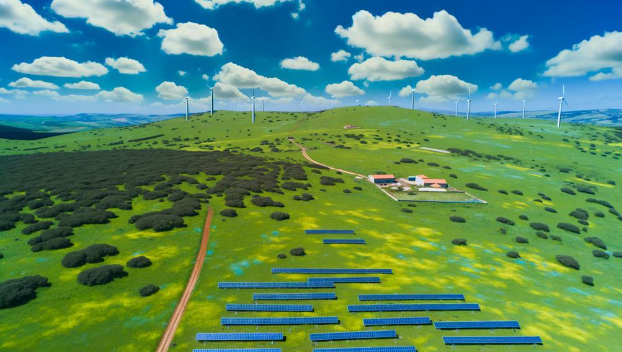
You’re considering transforming your land into a solar farm, but where do you start? First, take a close look at your property’s suitability by evaluating sunlight exposure and understanding local environmental regulations. It’s crucial to navigate the maze of legal requirements, like zoning and permits, to avoid costly mistakes. Financing can be daunting, so you should explore incentives and tax credits that might ease the financial burden. Choosing the right technology is another key step, but how do you ensure it’s the best fit for your land? Partnering with a reliable developer can make or break your project. Let’s explore what’s next.
Assess Land Feasibility
When you’re considering setting up a solar farm on your land and how to get a solar farm on your land, it’s crucial to frequently start by assessing land feasibility.
First, evaluate the environmental impact of your proposed site. Analyze factors like sunlight exposure and potential effects on local ecosystems. You want a location that maximizes solar gain while minimizing ecological disruption.
Next, consider the market demand for solar energy in your region. High demand can enhance profitability and justify the investment. Research local energy consumption patterns and future projections to guide your decision.
Strategically plan for infrastructure needs, like grid connectivity and access roads, which are vital for operational efficiency. Thoroughly assessing these elements ensures you select a site that supports both environmental sustainability and economic viability for your solar farm.
Understand Legal Requirements
Navigating the legal landscape is a critical step when setting up a solar farm. Start by understanding zoning regulations specific to your area. These dictate where solar farms are permissible, and ignoring them can lead to costly delays.
Next, familiarize yourself with the permitting process. It often involves multiple layers of approval, including local, state, and sometimes federal permits, each addressing unique concerns such as property boundaries and potential environmental impact. Ensuring your project complies with these requirements prevents legal complications.
Carefully verify property boundaries to avoid encroachment issues. Conduct an environmental impact assessment to identify any ecological concerns that could hinder your project’s approval. By addressing these legal elements strategically, you’ll streamline the path to establishing your solar farm.
Explore Financing Options
After ensuring your solar farm project aligns with legal requirements, the focus shifts to securing the right financing. Start by exploring government incentives designed to support renewable energy projects. These can significantly reduce initial costs and improve your project’s financial viability.
Research tax credits, grants, or low-interest loans available in your area. Next, evaluate potential investment returns by analyzing the expected energy output and market demand for solar power. This strategic approach helps you attract investors by showcasing profitability.
Consider partnering with financial experts to develop a compelling business plan that highlights both short-term and long-term gains. Don’t overlook the importance of a detailed cash flow analysis, as it ensures you can manage expenses while maximizing returns.
Choose the Right Technology
Selecting the right technology for your solar farm is critical to its success. Begin with a thorough technology comparison. Evaluate photovoltaic (PV) systems against concentrated solar power (CSP) units, focusing on efficiency analysis. PV systems offer high efficiency and lower initial costs, while CSP systems excel in large-scale energy production. Consider your land’s characteristics and local climate to determine the best fit.
Maintenance considerations are equally paramount. Opt for technology with manageable upkeep to reduce long-term costs. Assess the availability of spare parts and local expertise for repairs. Plan for future upgrades, ensuring the chosen technology can seamlessly integrate advancements. This strategic planning will enhance your solar farm’s performance, ensuring it remains productive and profitable for years to come.
Find a Reliable Developer
To ensure the success of your solar farm, you’ll need to find a reliable developer who can bring your vision to life. Start by conducting thorough developer vetting. Evaluate their track record in solar projects, checking for successful completions and client satisfaction.
Investigate their technical expertise and ability to handle the specific requirements of your land. A reliable developer will provide a clear project timeline, outlining each phase from planning to execution. This timeline should include critical milestones and deadlines, ensuring transparency and accountability.
Don’t hesitate to ask for references or case studies to validate their experience. A strategic partnership with the right developer will help mitigate risks and enhance the efficiency of your solar farm project.
Plan for Long-Term Management
Once you’ve secured a reliable developer, it’s important to shift focus towards the long-term management of your solar farm. Begin by establishing a robust maintenance schedule. Regular inspections and cleaning are crucial to keep the solar panels operating at peak efficiency. Work with your developer to set timelines for equipment checks and repairs. Don’t overlook vegetation management, as overgrowth can obstruct sunlight.
Next, develop clear revenue projections. Understand the expected energy output and the associated income. Factor in seasonal variations and potential degradation of solar panels over time.
Keep abreast of market trends and policy changes that might impact energy prices or incentives. By planning strategically, you’ll ensure your solar farm remains a profitable and sustainable venture for years to come.
Conclusion
Think of your land as a blank canvas, ready to catch the sun’s vibrant strokes. By assessing its feasibility, navigating legal mazes, and securing robust financing, you’re setting up a masterpiece. Choose technology that harmonizes with your landscape and partner with a trusted developer. With strategic planning, your solar farm will thrive like a well-tended garden. Stay vigilant, adapt to policy shifts, and let your solar legacy shine as a beacon of sustainable success.